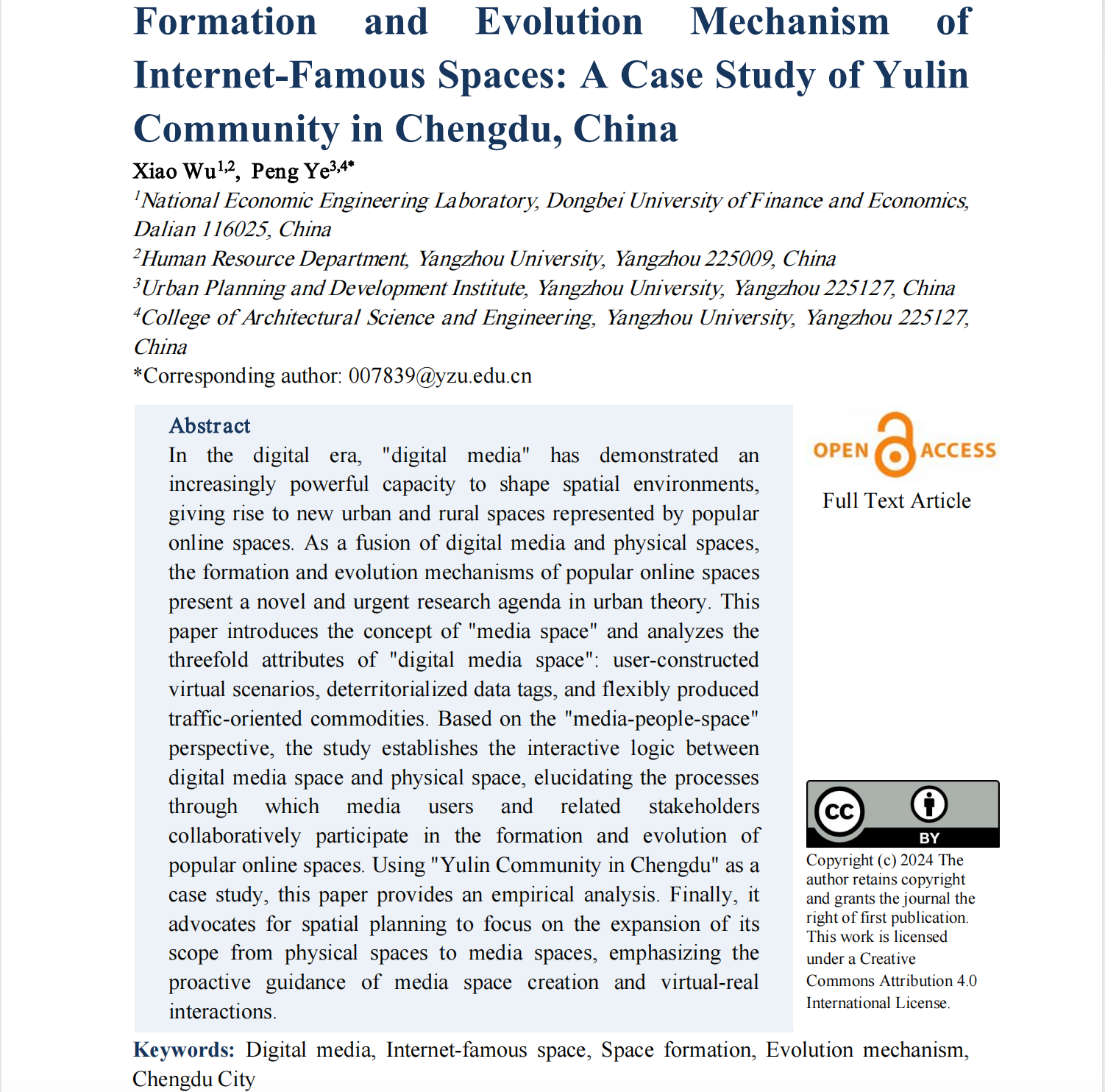Formation and Evolution Mechanism of Internet-Famous Spaces: A Case Study of Yulin Community in Chengdu, China
DOI:
https://doi.org/10.5281/zenodo.14263646Keywords:
Digital media, Internet-famous space, Space formation, Evolution mechanism, Chengdu CityAbstract
In the digital era, "digital media" has demonstrated an increasingly powerful capacity to shape spatial environments, giving rise to new urban and rural spaces represented by popular online spaces. As a fusion of digital media and physical spaces, the formation and evolution mechanisms of popular online spaces present a novel and urgent research agenda in urban theory. This paper introduces the concept of "media space" and analyzes the threefold attributes of "digital media space": user-constructed virtual scenarios, deterritorialized data tags, and flexibly produced traffic-oriented commodities. Based on the "media-people-space" perspective, the study establishes the interactive logic between digital media space and physical space, elucidating the processes through which media users and related stakeholders collaboratively participate in the formation and evolution of popular online spaces. Using "Yulin Community in Chengdu" as a case study, this paper provides an empirical analysis. Finally, it advocates for spatial planning to focus on the expansion of its scope from physical spaces to media spaces, emphasizing the proactive guidance of media space creation and virtual-real interactions.
References
[1] Dai, Z., & Hua, C. (2023). The duality of the capitalization of cultural resources on the rural development in the internet era. City Planning Review, 47(12), 13–20.
[2] Kuang, Z., & Lin, G. (2024). Consumption practices and production of space at internet-famous locations in the era of visualization: A case study of Better Days and its film location Chongqing. Tourism Tribune, 39(2), 74–88.
[3] Jin, S., Li, J., Li, Y., & Others. (2023). Space roaming and imagination production: Mediating construction of internet-celebrity cities in online pictures. Journalism & Communication, 30(5), 53–74, 127.
[4] Lv, F., & Wang, S. (2023). Research on the measurement and influencing factors of internet celebrity phenomenon in urban space. Urban Problems, 2023(12), 50–59.
[5] Wang, J., Mu, Y., & Wang, Z. (2022). Distribution and development of urban hot spots in the internet era: A case study of Shanghai. Urban Development Studies, 29(10), 19–26.
[6] Xiang, J., Luo, Z., Zhang, J., & Others. (2021). Research on the distribution characteristics of “net celebrity space” in the mobile internet era: A case study in main area of Hangzhou, China. Modern Urban Research, 2021(9), 11–19.
[7] Zhou, K., Zhang, H., Xia, Y., & Others. (2021). New urban consumption space shaped by social media: A case study of the geo-tagging places of Changsha on Xiaohongshu. Modern Urban Research, 2021(9), 20–27.
[8] Yang, Y., Cai, Y., Xu, Y., & Others. (2023). Spatial-temporal process and body’s behavior mechanism of consumers’ internet celebrity catering experience. Tourism Tribune, 38(10), 49–63.
[9] Luo, Z., Mao, M., Zhang, J., & Others. (2022). Takeaway factory: Formation mechanism of new urban spaces in the mobile internet era. Urban Planning Forum, 2022(4), 64–70.
[10] Zeng, Y., & Fan, T. (2022). Re-understanding “place”: The formation of Wanghong space and media sense of place—a study of “Da Ka” activities of the wall of Xi'an city. Journalism & Communication, 29(11), 71–89, 128.
[11] Luo, Z. (2020). E-garden city: Reconstruction of urbanization theory in the mobile internet era. City Planning Review, 44(3), 9–16, 83.
[12] Shao, P. (2021). New perspectives on geography of media. Hangzhou: Zhejiang University Press.
[13] Hanley, J. (1999). Uses of television. London: Routledge.
[14] Harvey, D. (1989). The condition of postmodernity: An enquiry into the origins of cultural change. Cambridge, MA: Blackwell.
[15] Crang, M. (1998). Cultural geography. London: Routledge.
[16] Gerbner, G., & Gross, L. (1976). Living with television: The violence profile. Journal of Communication, 26(2), 172–199.
[17] Couldry, N. (2003). Media rituals: A critical approach. London: Routledge.
[18] Dai, Z., Hua, C., & Tong, L. (2023). Virtual-physical relationship of future urban space: Based on the evolution of technology. City Planning Review, 47(2), 20–27.

Downloads
Published
How to Cite
Issue
Section
License
Copyright (c) 2024 Wu Xiao , Peng Ye

This work is licensed under a Creative Commons Attribution 4.0 International License.


























